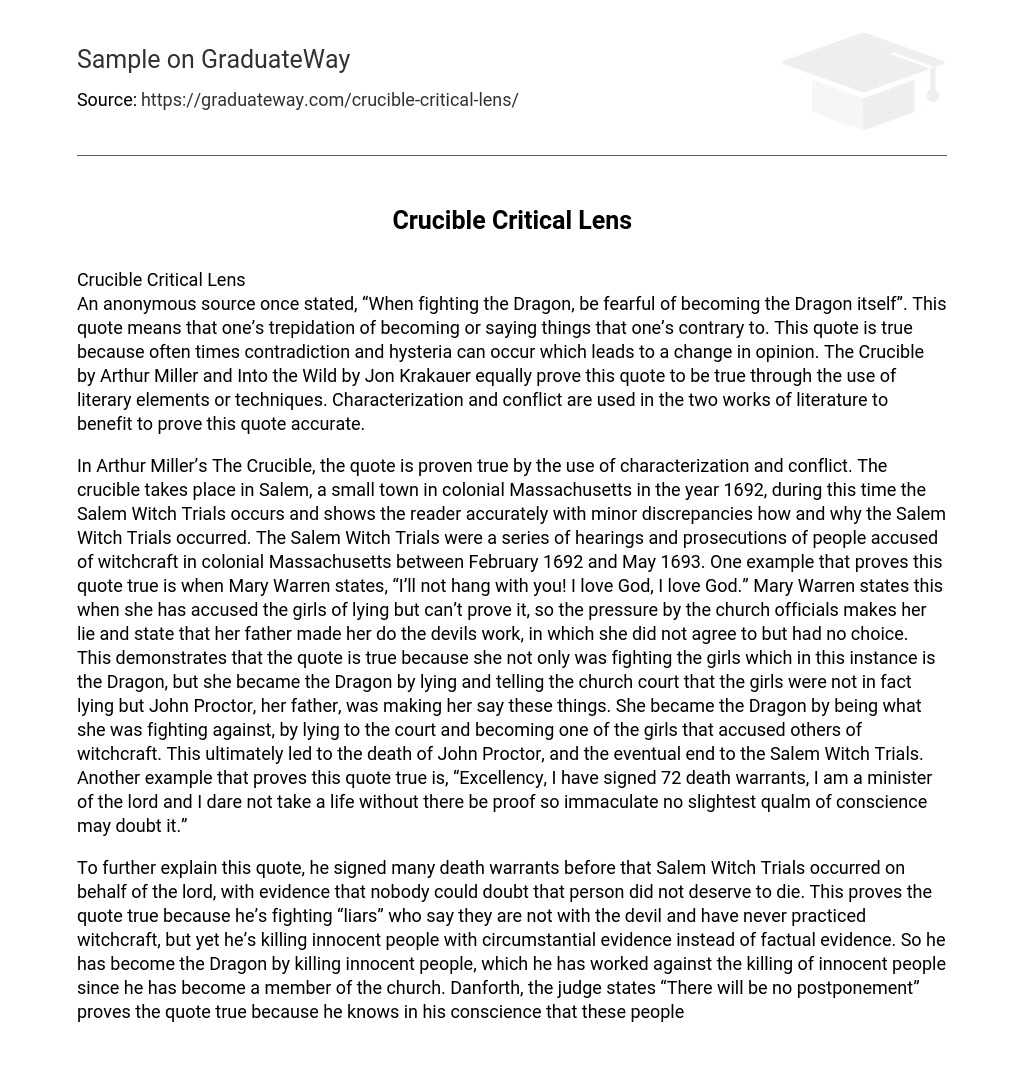According to an anonymous source, it is important to be cautious about transforming into the thing you are fighting against. This quote implies that one should avoid behaving in a manner contradictory to one’s beliefs. Indeed, contradiction and hysteria often arise and result in a shift in perspective. Arthur Miller’s The Crucible and Jon Krakauer’s Into the Wild effectively demonstrate the validity of this quote through their skilled use of literary techniques. Both works employ characterization and conflict to support the truthfulness of this statement.
Arthur Miller’s The Crucible demonstrates the truth of the quote through the use of characterization and conflict. Set in the small town of Salem, Massachusetts in 1692, during the infamous Salem Witch Trials, the play accurately portrays the events with slight variations. The trials were a series of hearings and prosecutions that took place between February 1692 and May 1693, accusing people of witchcraft. One example that supports the quote is when Mary Warren vehemently declares, “I’ll not hang with you! I love God, I love God!” This statement is made by Mary Warren when she exposes the girls for lying but is coerced into lying herself due to pressure from church authorities. She falsely claims that her father forced her to carry out evil deeds, although she did not willingly agree to it and had no other choice.
This passage illustrates the truth of the quote by demonstrating that she not only opposed and battled against the girls, symbolized as the Dragon, but also transformed into the Dragon herself. This transformation occurred when she lied to the church court, affirming the girls’ veracity while accusing her own father, John Proctor, of coercing her into falsehoods. In this manner, she assumed the very role she fought against by deceiving the court and aligning herself with a group of girls who accused others of practicing witchcraft. As a consequence, John Proctor met his demise and ultimately marked the culmination of the Salem Witch Trials. Another instance reinforcing this quote arises when someone declares, “Excellency, I have signed 72 death warrants; I am a minister of the lord and I cannot take a life without irrefutable evidence that leaves no room for doubt.”
The text argues that the quote is proved true through various examples. It mentions that the person in question signed death warrants before the Salem Witch Trials, believing that those condemned were guilty beyond doubt. This action contradicts his previous stance against killing innocent people, as he is now executing individuals based on circumstantial evidence rather than concrete proof. The judge, Danforth, also contributes to proving the quote true by refusing to postpone the trials despite knowing deep down that the accused are innocent. This reluctance stems from his desire to protect his reputation and avoid admitting fault. In this way, both individuals become the very thing they claim to fight against: the Dragon and the Devil. The conflict within these situations serves as a literary device that supports the truth of the quote.
Conflict in a story or play refers to the struggle between opposing forces that is typically resolved by the end of the work. This conflict can exist within a character or between characters and nature. In The Crucible, the conflict between Proctor and Abigail is a prime example. When Proctor admits to witchcraft by signing the document, he takes on the role of the Dragon, which is symbolized by Abigail. This highlights how conflict can arise within and between characters. Additionally, characterization is a literary device that authors use to present and reveal character traits. An illustration of this can be seen in Reverend Parris, who prioritizes protecting his daughter over allowing a fair trial, ultimately leading to innocent lives being lost. Arthur Miller’s The Crucible effectively employs characterization and conflict to support the validity of this quote.
Jon Krakauer effectively uses conflict and characterization in his novel, Into the Wild, to support the validity of a quote. The story centers on Chris McCandless, also known as Alex Supertramp, as he embarks on a journey across various locations in the United States including Alaska, Mexico, Virginia, and the western part of the country. McCandless faces ongoing battles with nature during his time in Alaska where he teeters on the edge of death before ultimately succumbing to its forces. This intense conflict between man and nature exemplifies the truth of the quote as he transforms into what he was fighting against. Additionally, McCandless’s fear of society is a recurring theme throughout the book; despite desiring solitude, it is ultimately his isolation that proves fatal for him. In desperate moments within a bus, he realizes his need for people more than ever. This conflict with society further reinforces the accuracy of the quote as McCandless becomes a society unto himself while struggling to survive without human companionship.
Characterization is another literary device employed in Into the Wild to support the validation of this quote. A prime instance of characterization is evident when Chris McCandless struggles to distance himself from his parents; however, following his demise, it merely conspired to strengthen their bond. This substantiates the quote, as McCandless was battling against his parents and striving to escape from them, symbolizing the Dragons, but ultimately they ended up growing even more attached to him and yearned to be united with him even further.
The quote “When fighting the Dragon, be fearful of becoming the Dragon itself” holds true in both Into the Wild by Jon Krakauer and The Crucible by Arthur Miller. Both works of literature utilize characterization and conflict to illustrate the validity of this quote. Essentially, this quote warns against adopting the characteristics or beliefs that one opposes.





